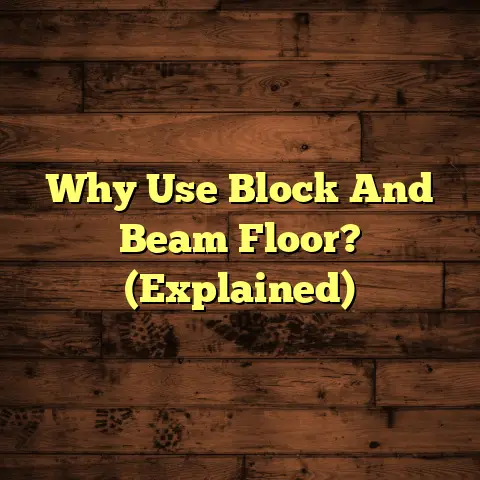Paint Wood Floors Black? (3 Coat Mistakes!)
But let me tell you, painting wood floors black isn’t as simple as slapping on a coat of paint. Trust me, I’ve seen it all in my years as a flooring contractor.
I’ve witnessed some spectacular successes, and some… well, let’s just say they were learning experiences.
The secret? Avoiding common pitfalls. That’s why I’m here to guide you through the process and help you dodge the three major mistakes that can turn your dream floors into a DIY disaster.
Ready to dive in? Let’s do this!
Understanding the Appeal of Black Wood Floors
Why black floors, you ask? Oh, let me count the ways!
Black wood floors are like the little black dress of interior design – always stylish and incredibly versatile.
They can effortlessly complement a range of design themes. Think minimalist, where black floors provide a grounding anchor.
Or industrial, where they enhance the raw, edgy vibe. Even rustic spaces can benefit, with black floors adding a touch of sophistication and contrast.
One of the biggest advantages is the sense of depth and contrast they create. A dark floor makes lighter walls and furniture pop, adding visual interest and drama to a room.
Imagine a bright white sofa against a backdrop of rich, black wood – stunning, right?
Plus, let’s be honest, black floors are fantastic at hiding minor imperfections. Scratches and dents are far less noticeable than on lighter-colored floors.
Now, I’m not saying they’re completely scratch-proof, but they definitely offer a bit more forgiveness.
I’ve seen black wood floors used to great effect in various spaces. Lofts with exposed brick walls and metal accents look incredible with dark flooring.
Modern apartments with clean lines and minimalist décor are instantly elevated. Even cozy cottages can benefit, with black floors adding a touch of unexpected sophistication.
Interior design trends are definitely leaning towards darker flooring options. According to a recent survey by the National Wood Flooring Association (NWFA), dark stains and paints are gaining popularity. NWFA Website
This trend reflects a desire for bolder, more dramatic interiors. People are embracing the idea of making a statement with their floors, and black is a powerful way to do just that.
Preparation is Key
Okay, so you’re sold on the idea of black wood floors. Awesome! But before you even think about cracking open a can of paint, you need to focus on preparation.
Trust me, this is where most DIYers go wrong. Skipping steps here will haunt you later.
First, you need to thoroughly clean your floors. I’m not talking about a quick sweep and mop.
We’re talking deep cleaning. Use a wood floor cleaner to remove all dirt, grime, and old wax buildup.
I personally recommend using a product like Bona Hardwood Floor Cleaner. It’s effective yet gentle on wood.
Next up: sanding. This is crucial for creating a smooth surface for the paint to adhere to.
You don’t need to sand down to bare wood, but you do need to remove any existing finish and create a slightly roughened surface.
For this, I recommend using a drum sander for large areas and an orbital sander for edges and corners. Start with a coarse grit sandpaper (like 60-grit) and gradually work your way up to a finer grit (like 100-grit).
Pro Tip: Always sand with the grain of the wood to avoid creating unsightly scratches.
Now, let’s talk primer. Primer is your best friend when painting wood floors. It creates a barrier between the wood and the paint, ensuring better adhesion and preventing the paint from soaking into the wood.
I typically use an oil-based primer for wood floors, as it provides excellent sealing properties. However, water-based primers are also a good option, especially if you’re concerned about VOCs (volatile organic compounds).
Kilz is a reliable brand for both oil-based and water-based primers.
Temperature and humidity play a significant role in paint adherence and drying times. Ideally, you want to paint your floors when the temperature is between 60-80°F and the humidity is below 50%.
High humidity can slow down drying times and lead to paint that doesn’t adhere properly.
Now, let’s get to that first coat mistake: skipping essential preparation steps. I cannot stress this enough – do not skip the prep work!
Inadequate preparation can lead to a whole host of problems. Peeling, bubbling, uneven application – you name it, I’ve seen it.
Imagine spending hours painting your floors only to have the paint start peeling a few weeks later. Talk about a nightmare!
Proper preparation ensures a smooth, durable finish that will last for years to come. Trust me, it’s worth the extra effort.
Choosing the Right Paint
Okay, your floors are prepped and ready to go. Now it’s time to choose the right paint. This is another area where many DIYers stumble.
Not all paints are created equal, especially when it comes to wood floors. You need a paint that is durable, scuff-resistant, and designed to withstand heavy foot traffic.
Let’s break down the different types of paint suitable for wood floors.
-
Oil-Based Paint: Oil-based paints are known for their durability and smooth finish. They provide excellent coverage and are resistant to scratches and scuffs. However, they have a longer drying time and a strong odor.
-
Water-Based Paint: Water-based paints are a more eco-friendly option with low VOCs and easy cleanup. They dry faster than oil-based paints but may not be as durable.
-
Specialty Floor Paints: These paints are specifically formulated for wood floors and offer excellent durability and resistance to wear and tear. They are typically more expensive than regular paints but are worth the investment for high-traffic areas.
I usually recommend using a specialty floor paint for the best results. Brands like Benjamin Moore and Sherwin-Williams offer excellent options.
Choosing high-quality paint is crucial for durability and finish. Cheap paint may seem like a good deal, but it will likely chip, scratch, and fade over time.
Investing in a high-quality paint will save you money in the long run by reducing the need for frequent touch-ups and repainting.
Now, let’s talk about the second coat mistake: using the wrong type of paint. I’ve seen people try to use everything from latex wall paint to craft paint on their wood floors.
Big mistake!
These paints are not designed for the wear and tear of foot traffic and will quickly fail. They may peel, chip, or become sticky and difficult to clean.
For example, using latex wall paint on your floors will result in a soft, easily damaged surface. It won’t hold up to everyday use and will quickly show signs of wear.
Similarly, using craft paint will result in a thin, uneven finish that is easily scratched and damaged.
Always choose a paint that is specifically designed for wood floors. Read the label carefully and make sure it is suitable for your intended use.
Application Techniques
Alright, you’ve got the right paint. Now it’s time to apply it like a pro. The application technique is just as important as the paint itself.
Let’s start with the tools you’ll need. You’ll need a good quality paintbrush for cutting in around the edges, a roller for covering large areas, and a paint tray.
Some people prefer to use a sprayer for applying paint to wood floors. This can result in a very smooth, even finish, but it requires more skill and experience.
If you’re using a sprayer, be sure to thin the paint according to the manufacturer’s instructions and practice on a scrap piece of wood before tackling your floors.
When applying paint to wood floors, it’s always better to apply multiple thin coats rather than fewer thick coats.
Thick coats of paint take longer to dry and are more likely to drip, sag, and bubble. Thin coats dry quickly and evenly, resulting in a smoother, more durable finish.
I typically recommend applying at least two coats of paint to wood floors, and sometimes even three coats for high-traffic areas.
Allow each coat to dry completely before applying the next coat. This will ensure that the paint adheres properly and that you achieve a uniform finish.
Now, let’s talk about the third coat mistake: applying too thick a layer of paint. This is a common mistake that can lead to a whole host of problems.
Thick coats of paint take longer to dry, which can lead to dust and debris getting stuck in the paint. They can also sag, drip, and bubble, resulting in an uneven, unattractive finish.
To avoid applying too thick a layer of paint, use a high-quality roller and apply the paint in thin, even strokes. Don’t overload the roller with paint, and be sure to overlap each stroke slightly to avoid gaps.
If you notice any drips or sags, smooth them out immediately with a brush or roller.
Remember, patience is key. It’s better to take your time and apply multiple thin coats than to rush the job and end up with a messy, uneven finish.
Curing and Maintenance
You’ve painted your floors, and they look amazing! But the job isn’t done yet. Now you need to let the paint cure properly.
The curing process is essential for allowing the paint to fully harden and bond to the wood. During this time, it’s important to protect the surface from damage.
The curing time will vary depending on the type of paint you used and the environmental conditions. However, as a general rule, you should wait at least 24-48 hours before walking on the floors.
Avoid placing furniture on the floors for at least a week. This will give the paint time to fully cure and harden.
During the curing process, it’s important to keep the floors clean and dry. Avoid mopping or scrubbing the floors, as this can damage the paint.
Once the paint has fully cured, you can begin to clean and maintain your black- painted wood floors.
Here are a few tips for keeping your floors looking their best:
-
Sweep or vacuum regularly: This will remove dirt and debris that can scratch the paint.
-
Use a damp mop to clean: Avoid using harsh chemicals or abrasive cleaners, as these can damage the paint. I recommend using a wood floor cleaner like Bona.
-
Use floor mats in high-traffic areas: This will help protect the floors from wear and tear.
-
Avoid wearing shoes with sharp heels: These can scratch the paint.
-
Trim your pets’ nails: This will help prevent scratches.
Even with proper care, your black-painted wood floors will eventually show signs of wear. Scratches, scuffs, and fading are all normal signs of use.
When you start to notice significant wear and tear, it may be time to consider repainting your floors.
The good news is that repainting is much easier than the initial painting process. You’ll simply need to lightly sand the floors, clean them thoroughly, and apply a fresh coat of paint.
Conclusion
So, there you have it – a comprehensive guide to painting wood floors black and avoiding those common mistakes!
Remember, careful preparation, the right materials, and proper application techniques are the keys to success.
Skipping steps or cutting corners will only lead to frustration and disappointment.
By avoiding the three coat mistakes I’ve discussed, you can achieve a beautiful and durable finish that will enhance the overall look of your home.
Black-painted wood floors are a bold and stylish choice that can add a touch of sophistication to any space. With a little bit of effort and attention to detail, you can transform your floors into a stunning focal point that you’ll be proud of for years to come.
Now go forth and create some amazing floors! You got this!





